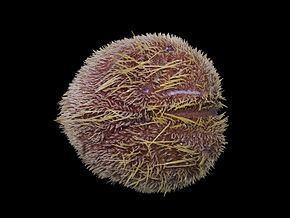Irregularia is an extant infraclass of sea urchins that first appeared in the Lower Jurassic.
Description and characteristics
These particular sea urchins are distinguished from other sea urchins by their irregular shape : the anus and often even the mouth are no more at the two poles of the test, creating a bilateral symmetry instead of the classical 5-fold symmetry of echinoderms. The group includes the well known heart urchins, as well as flattened sand dollars, sea biscuits and some other forms. Most of them live inside the sediment, movin in thanks to their particular spines, and feed on its organic fraction.
super-order Atelostomatafossil family Acrolusiidae Mintz, 1968 †fossil family Collyritidae d'Orbigny, 1853 †fossil family Disasteridae Gras, 1848 †order Holasteroidaorder Spatangoidafossil family Tithoniidae Mintz, 1968 †fossil genus Atlasaster Lambert, 1931 †fossil family Desorellidae Lambert, 1911a †order Echinoneoidafossil family Galeropygidae Lambert, 1911a †fossil genus Grasia Michelin, 1854 †fossil order Holectypoida †fossil family Menopygidae Lambert, 1911 †fossil genus Mesodiadema Neumayr, 1889 †super-order Neognathostomatafamilia Apatopygidae Kier, 1962fossil family Archiaciidae Cotteau & Triger, 1869 †order Cassiduloidaorder Clypeasteroidafossil family Clypeidae Lambert, 1898 †fossil family Clypeolampadidae Kier, 1962 †order Echinolampadoidafossil family Nucleolitidae L. Agassiz & Desor, 1847 †fossil family Pygaulidae Lambert, 1905 †fossil genus Pygolampas Saucède, Dudicourt & Courville, 2012 †fossil family Pygasteridae Lambert, 1900 †fossil family Pygorhytidae Lambert, 1909b †
